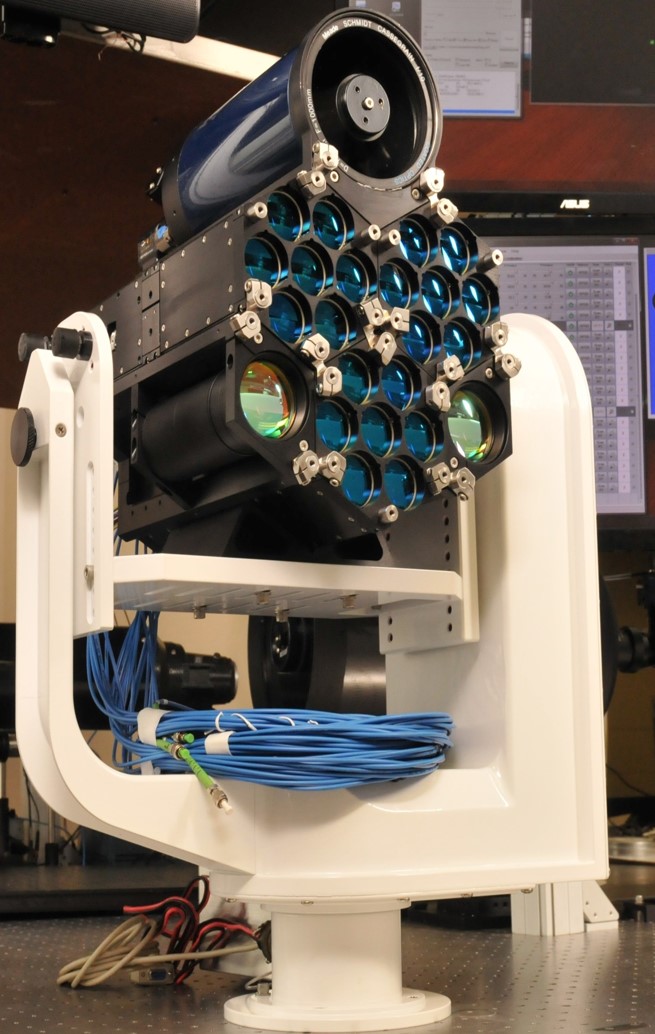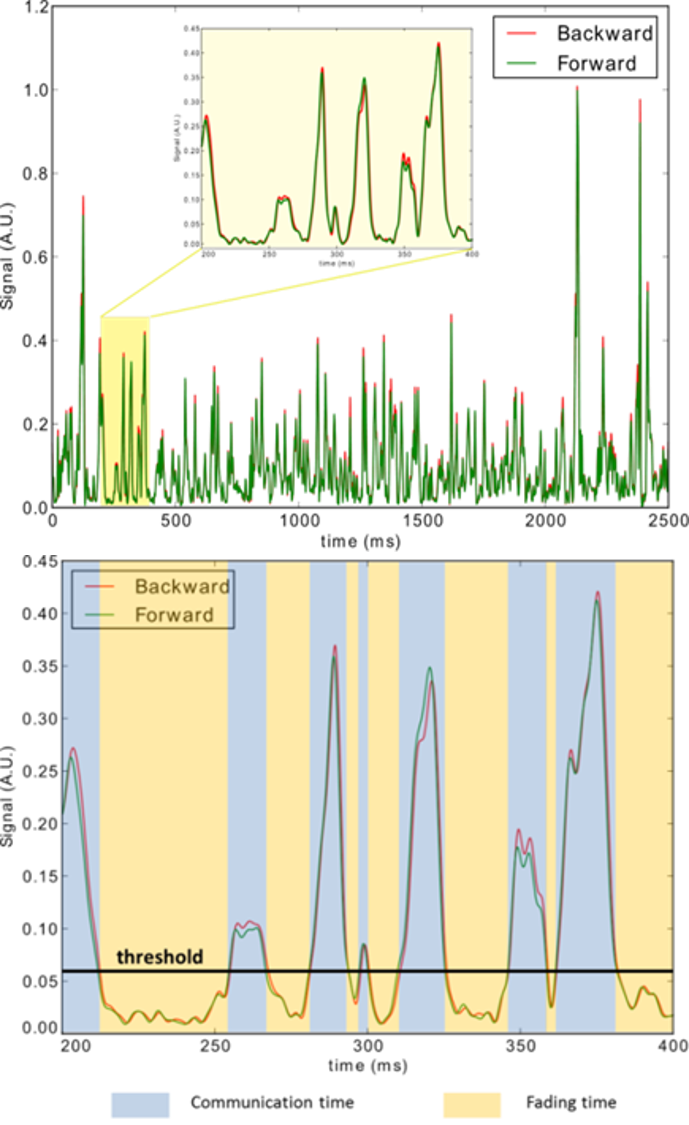To address the existing technology shortfalls and support very high bandwidth communications in a wide variety of weather conditions, Optonicus offers innovative, modular, eye-safe optical and hybrid (Optical/RF) communication systems based on arrays of synchronously-operated small-size adaptive laser communication nodes. These systems have many applications including:
- Satellite Optical Communications
- Border Control Image Transfer
- Airborne Intelligence
- Surveillance
- Reconnaissance
- High-Speed Data Transfer
- Modular fiber-array adaptive laser transmitter system developed by Optonicus. The system is composed of 21 adaptive fiber-collimators, pointing and tracking telescope (on top) and two feedback receiver sensors (bottom left and right). The fiber-array is integrated into a gimbal platform for moving target tracking. The system evaluation included successful demonstration of coherent beam combining (phasing) and adaptive compensation of deep turbulence effects over 7 km atmospheric path.
- One of the major drawbacks of the existing long-range free-space laser communication technology is the use of conventional transmitter and receiver (transceiver) telescopes with monolithic optics. For long-range applications that require relatively large transmitter and/or receiver aperture size, this conventional approach leads to bulky, heavy and expensive systems that are neither scalable nor easily deployable. This shortcoming of conventional laser communication systems is overcome in the Optonicus fiber-array based modular adaptive laser communication terminal that is composed of densely packed adaptive laser communication transceivers (nodes).
- Each ALCO transceiver includes a fiber collimator with an input laser beam entering through a fiber tip located at the collimating lens focus. The input laser beams are delivered into these fiber tips using a multi-channel fiber system with either a single eye safe 1550 nm laser source, or an array of independent fiber-coupled laser sources that are compliant with the standard wavelength division-multiplexing (WDM) wavelength grid spacing capable of supporting multiple channels at 2.488 Gb/s data traffic per channel (SONET OC-48).
- In the Optonicus FSO communication terminals AO mitigation of tip and tilt aberrations is performed using the stochastic parallel gradient descent (SPGD) feedback controller, an Optonicus' standard product that maximizes the received optical power by controlling the x- and y-positions of the fiber tips inside the transceivers.


ALCO Transceiver


Optonicus communication systems are designed to be resilient in respect to high turbulence-induced signal fading due to utilization of the innovative turbulence enhanced cooperative optical communication (TECO_COM) technique.
TECO_COM is based on Helmholtz's well-known reciprocity theorem which states that the received field remains equal when the position of the point source and the point receiver are interchanged. This theorem remains valid even when these two points are separated by a turbulent atmosphere. Most recent experiments over a 7-km atmospheric propagation path with a duplex (bi-directional) laser communication system and numerical simulations conducted at the University of Dayton (UD) in collaboration with Optonicus have supported this evidence. A correlation higher than 99% can be reached between the fluctuations of received power on both ends. High correlation between the signals enables a natural and automatic collaboration between the transceivers: each transceiver stops sending information when it's received signal falls below a certain threshold and resumes sending data when the atmospheric channel improves.
This unique concept enables the following advantages:
- Reduction in the Bit Error Rate (BER) of the FSO communication link, enabling reliable high-speed data transfer.
- Use of lower laser power, thus enabling low-cost, low power, robust transceivers.
- Reduction in the probability of interception compared to conventional FSO communication links.
- A simple and reliable key distribution mechanism to improve the security of the communication.
The high correlation of the simultaneously recorded forward and backward signals received by either transceiver demonstrates that when the communication link is poor in one direction, it is also poor in the other direction. To reduce the bit error rate, it is beneficial to temporarily stop the data transmission from when the signal received is insufficient. Below Figure illustrates this basic idea: transceivers stop sending data when the received signal falls below a threshold ("fading time" windows indicated by yellow) and resume sending data when the channel is healthy again ("communication time" windows indicated by blue). Due to the high correlation between the signals, both transceivers stop/resume transmitting the data virtually at the same time.
Digital Signal Processing ensures the buffering of data during fading time intervals in First-In First-Out (FIFO) memories. A threshold detector is implemented, which constantly monitors the received signal level and compares it to the predefined threshold. For a 1 GigE data input, a FIFO memory of 1 GB can store up to 8 seconds of consecutive fading time. Reciprocity experiments showed that typical fading intervals in normal weather conditions do not exceed the 100ms period. Because the optical link works with speeds of 10 Gbps, data is consumed by the FIFO memory 10 times faster than it is produced by the input, which ensures prevention of memory overflow and data loss. This technique allows high data throughput even in times of high atmospheric turbulence.

Conceptual design of the TECO_COM reciprocity-based, adaptive Quality of Service (QoS), mixed FSO/RF transceiver.
In bad weather conditions, fading times may get longer and the proportion of fading time versus communication time will get bigger which may produce a FIFO memory overflow. To avoid this scenario and keep a high reliability link, the FIFO memory level is constantly monitored and when it reaches a predefined threshold, the system will adapt itself by triggering the demultiplexer implemented in the signal processing part of the system and an RF link is established to insure the continuity of the communication. This will degrade the throughput of the system by slowing down the communication speed (to a 200 Mbps RF link), but will maintain a very high reliability in all weather conditions.The digital processing part of the TECO_COM transceiver (including the FIFO memories, threshold detector, Ethernet controller and FSO/RF multiplexers) is implemented in-house on a Xilinx Zynq-7045 SoC (System on Chip). This board includes a Kintex 7 Field Programmable Logic Array (FPGA) and two ARM® CortexT-A9 MPCoreT processors. The implementation on this SoC insures real-time operation of the TECO_COM transceiver.
